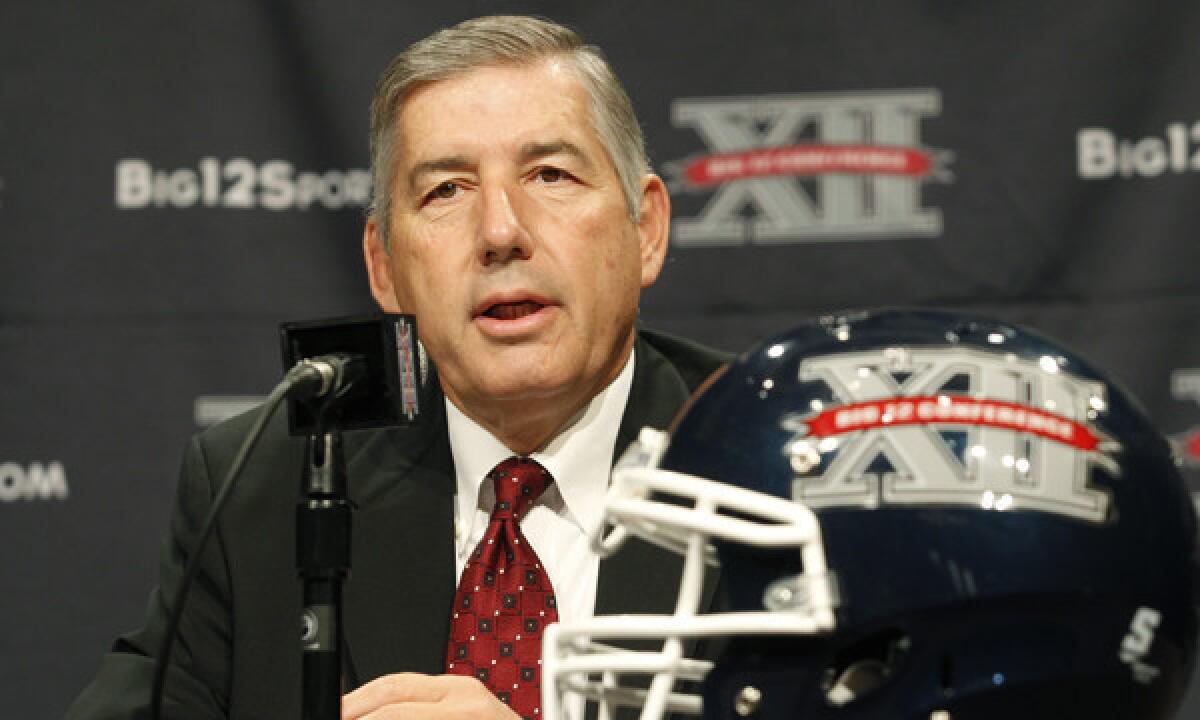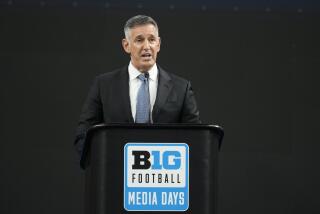As college football season approaches, power conferences seek change

- Share via
Welcome to the season Urban Meyer, Mark Emmert and Johnny Manziel can’t wait to get started.
All three of these men, in some form or fashion, had issues with their snooze alarms.
Oregon skips merrily into fall camp like a schoolchild after getting a probationary wrist slap only a few years after the NCAA sent USC to San Quentin for jaywalking.
USC Coach Lane Kiffin is reportedly not on the hot seat despite what happened last year on the surface of the Sun Bowl.
And get this: UCLA not only won its first NCAA baseball title with its brand of gutty-little-Bruins ball, but it also has been picked to finish ahead of USC in football for the first time since 2001.
Can’t wait for the new improved show: “Whose Town Is It Anyway?”
Football was put on Earth because it is fantastically fun. But it has also loathsomely become a “Bonfire of the Vanities” of power, control, greed, money, access and more power.
This is the 16th (and last) year of the tired Bowl Championship Series, as the sport dramatically transitions, recalibrates and uncomfortably squirms.
While England rejoices over the birth of young Prince George, everyone here knows the Southeastern Conference is the king that lords over its subjects. The league has won seven straight national titles and will be favored to win its eighth.
Commissioner Mike Slive, an avuncular guy who calls himself a “recovering lawyer,” opened his SEC state of the union news conference with his usual “brag bag” of accomplishments.
Bully (pulpit) for him.
The operative word moving forward, though, is “change.”
Some of it has already been formally rubber-stamped.
A four-team playoff is coming in two years but not until the Rose Bowl hosts its 100th game on Jan. 1 and the last BCS title game is played Jan. 6.
Schools are switching leagues almost as fast as coaches are switching schools.
The change gurgling below, though, is about the consolidation of power.
Darwinism has already claimed Big East football and left five power leagues to distribute $5.6 billion over the next 12 years.
The big boppers are the SEC, Big Ten, Pac-12, Atlantic Coast Conference and Big 12, which have severely separated themselves from “the Group of Five”: Mountain West, Mid-American Conference, Sun Belt, Conference USA and the new American Athletic Conference.
The Power Five controls about 75% of the new money and wants to use it to pay its scholarship student-athletes a “full cost of attendance” stipend ranging from $2,000 to $5,000 per year.
It’s a noble gesture and also a convenient power grab to further segregate from the working class.
The move, though, is being blocked by a majority of 348 schools in the NCAA’s top division (those ungrateful, whiny, non-football powers).
The Big Five could choose to break away from the NCAA and form its own organization.
“I don’t see secession as a legitimate point of leverage except as a last resort,” Big 12 Commissioner Bob Bowlsby said at media day.
It was news, though, that Bowlsby even mentioned the “S” word.
The five power commissioners have strategically used increasingly magnified NCAA dysfunction under its president, Emmert, to launch its agenda armada.
The commissioners, one by one, almost in orchestrated concert, started laying out the future in their media-day addresses.
Bowlsby said, “Transformative change is going to have to happen.”
Big Ten Commissioner Jim Delany, more of a traditionalist, framed it this way: “I think there’s a lot of momentum for the tradition, but there are also head winds out there also.”
Slive mentioned in his address, “The NCAA has not been successful in meeting the full cost of attendance of our future athletes.”
Pac-12 Commissioner Larry Scott said Friday the message was not necessarily coordinated among the commissioners. He said everything just sort of chain-reacted after Slive’s opening-salvo comments.
Scott thought Bowlsby’s comments about secession could have been misinterpreted.
Scott said the major football conferences can, and should, solve their problems as members of the NCAA.
He said, “I believe it would be a colossal failure by everyone” to take major college football outside the system.
The power brokers simply want to use their wildly disproportionate amount of television money the way they want.
The commissioners who cut the humongous TV deals have taken a stranglehold on the sport since the Supreme Court ruled 30 years ago the NCAA was a monopoly with no right to dictate how many games could be televised.
“You can’t lose focus on the fact that before the NCAA lost control of college football TV, we had one game on a week,” Delany said at Big Ten media day.
The five power conferences could opt to form another division within the NCAA.
“It’s an option,” Scott said Friday, “but it might not be necessary.”
Scott thinks the bureaucratically bogged down NCAA simply needs to become more “nimble and flexible.”
Emmert, who has maneuvered himself into a box, seems agreeable to this and has promised significant change within a year.
Some would say: What other choice does he have?
History has proved that, in most cases, you should never bet against power and money.
In the college world, football is power, and football is money.
More to Read
Go beyond the scoreboard
Get the latest on L.A.'s teams in the daily Sports Report newsletter.
You may occasionally receive promotional content from the Los Angeles Times.











